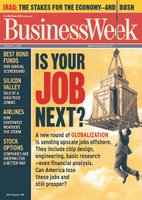One question that swirls around the current immigration debate is whether or not a 700-mile wall should be built along the 1,952-mile border w/ Mexico. The House approved $2.2 billion for the wall back in December 2005 to "build a double set of steel walls with floodlights, surveillance cameras and motion detectors along one-third of the U.S.-Mexican border." 1 The Senate approved the bill shortly afterwards.
 On Thursday, October 26, President Bush signed this bill into law. "Unfortunately the United States has not been in complete control of its borders for decades and therefore illegal immigration has been on the rise," Bush said at a signing ceremony. He called the fence bill "an important step in our nation's efforts to secure our borders." 3 (What's interesting to note about this Yahoo article that I quoted from here is that it can't even figure out how long the southern border of the U.S. is. One part of the article says it's a "nearly 2,000-mile border" while another part of the article refers to the "fence project covering one-third of the 2,100-mile border." Last time I checked, we haven't changed our southern border with Mexico since the Gadsden Purchase in 1853.)
On Thursday, October 26, President Bush signed this bill into law. "Unfortunately the United States has not been in complete control of its borders for decades and therefore illegal immigration has been on the rise," Bush said at a signing ceremony. He called the fence bill "an important step in our nation's efforts to secure our borders." 3 (What's interesting to note about this Yahoo article that I quoted from here is that it can't even figure out how long the southern border of the U.S. is. One part of the article says it's a "nearly 2,000-mile border" while another part of the article refers to the "fence project covering one-third of the 2,100-mile border." Last time I checked, we haven't changed our southern border with Mexico since the Gadsden Purchase in 1853.)So, what do you think? Does America need this wall? Why or why not? Read the articles on illegal immigration and decide before answering. Check on the links below to read some opinions. Your answer should be 150 words or more. Answer by Sunday night 10/29/06, 11:59 p.m.
1. Article from the San Fransico Chronicle: http://www.sfgate.com/cgi-bin/article.cgi?f=/c/a/2006/02/26/BORDERFENCE.TMP
2. Diagram of wall taken from website: http://www.dakotavoice.com/images/fence.jpg
3. http://news.yahoo.com/s/ap/20061026/ap_on_go_pr_wh/bush_immigration_8

